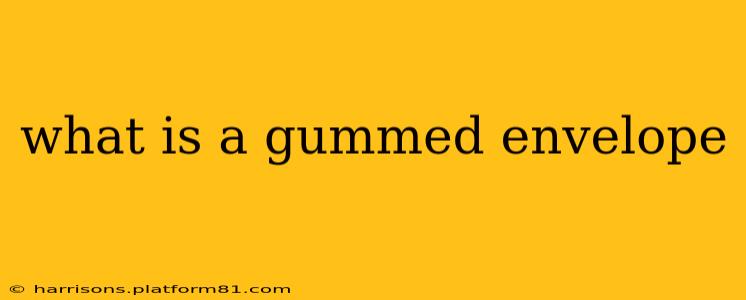A gummed envelope is a type of envelope that features a strip of gum or adhesive along one edge, typically the flap. This adhesive is designed to seal the envelope securely without the need for additional sticky tape or glue. The gum is often activated by moistening it with water or your tongue, allowing the flap to adhere firmly to the envelope body. They offer a classic, reliable method of sealing mail and are still used today, although less frequently than self-adhesive envelopes.
How Does a Gummed Envelope Work?
The gumming process involves applying a water-activated adhesive to the envelope's flap during manufacturing. This adhesive is typically a type of starch-based gum, although modern alternatives exist. When moistened, this gum becomes tacky, allowing the flap to adhere strongly to the envelope's body, creating a secure seal. The strength and longevity of the seal depend on the quality of the gum and how effectively it is moistened.
What are the Advantages of Gummed Envelopes?
While less common now, gummed envelopes offer several advantages:
- Security: When properly sealed, they provide a secure closure, making them ideal for sensitive documents or valuable items. The seal is less likely to come undone than a poorly sealed self-adhesive envelope.
- Cost-effective (in bulk): In large quantities, they can be cheaper than self-adhesive envelopes, particularly if purchased from wholesale suppliers.
- Traditional Aesthetic: Their classic look and feel can be appealing for certain applications, like formal invitations or handwritten correspondence.
- Environmental Considerations: Some gummed envelopes use plant-based adhesives, making them a more eco-friendly option compared to some self-adhesive alternatives.
What are the Disadvantages of Gummed Envelopes?
Despite their advantages, gummed envelopes also have some drawbacks:
- Messiness: Moistening the gum can be messy and time-consuming, particularly when dealing with a large number of envelopes.
- Inconvenience: Requiring water or a moistened sponge adds a step to the mailing process.
- Storage: Improper storage can lead to the gum drying out and becoming unusable. They need to be stored in a cool, dry place to maintain the adhesive's effectiveness.
- Less Convenient for High Volume Mailing: The manual application of moisture makes them impractical for large-scale mailings.
Are Gummed Envelopes Still Used?
Yes, gummed envelopes are still used, though their popularity has declined with the rise of self-adhesive envelopes. They remain a viable option for situations requiring a strong, secure seal or those seeking a classic, traditional look. You'll likely find them used in more formal settings or for situations where security is paramount.
What are the Different Types of Gummed Envelopes?
While the basic principle remains the same, gummed envelopes come in various sizes, colors, and weights, offering options to suit different needs. Some may have additional features like windows or different flap styles.
How Do I Seal a Gummed Envelope?
Simply moisten the gummed strip with a damp sponge or your tongue (though using a sponge is more hygienic). Press the flap firmly against the envelope body to ensure a secure seal. Allow the gum to dry completely for a stronger bond.
Where Can I Buy Gummed Envelopes?
Gummed envelopes can often be found at office supply stores, stationery shops, and online retailers. Wholesale suppliers may offer better pricing for bulk orders. However, finding them may require more effort than finding self-adhesive options, as they're less widely stocked.
